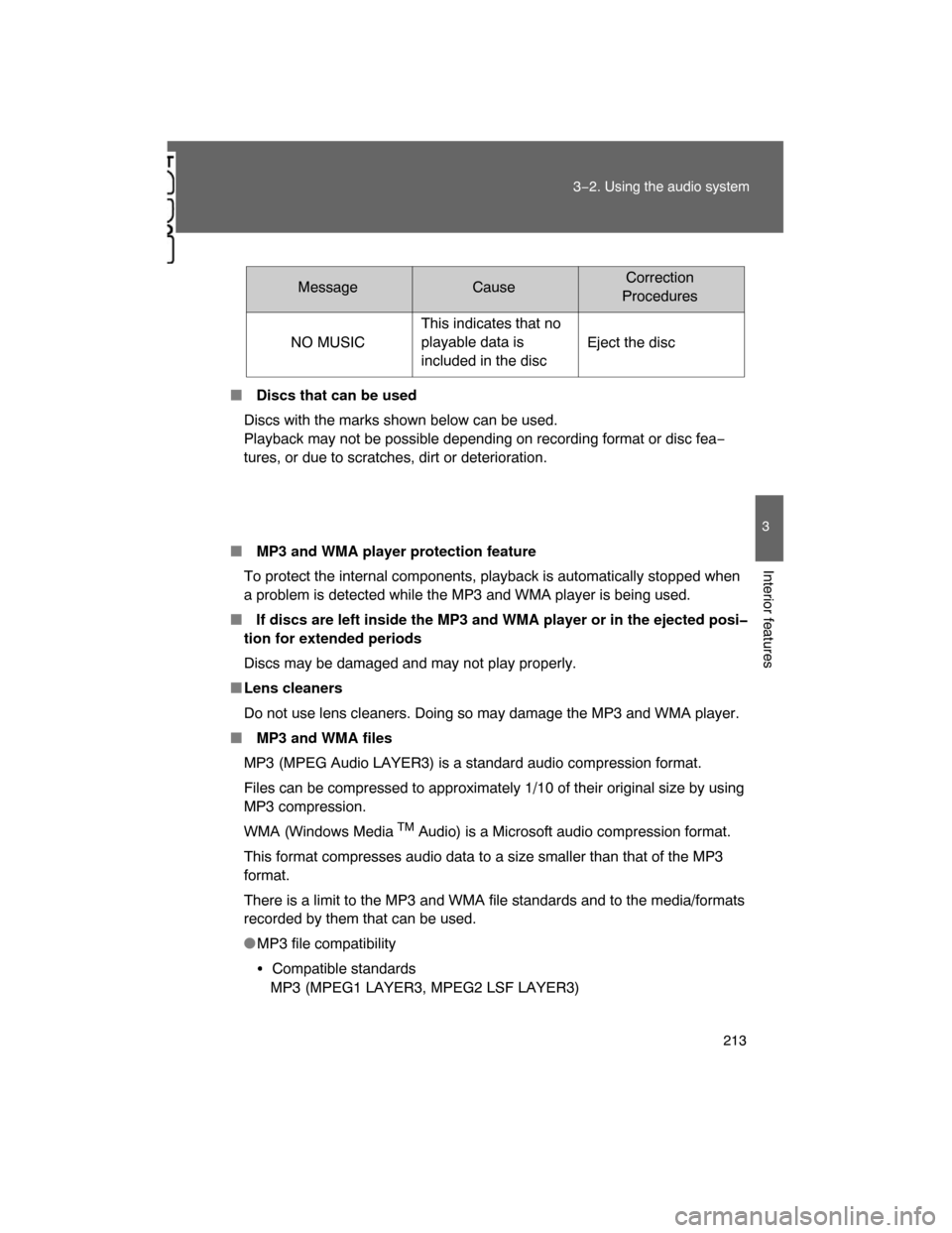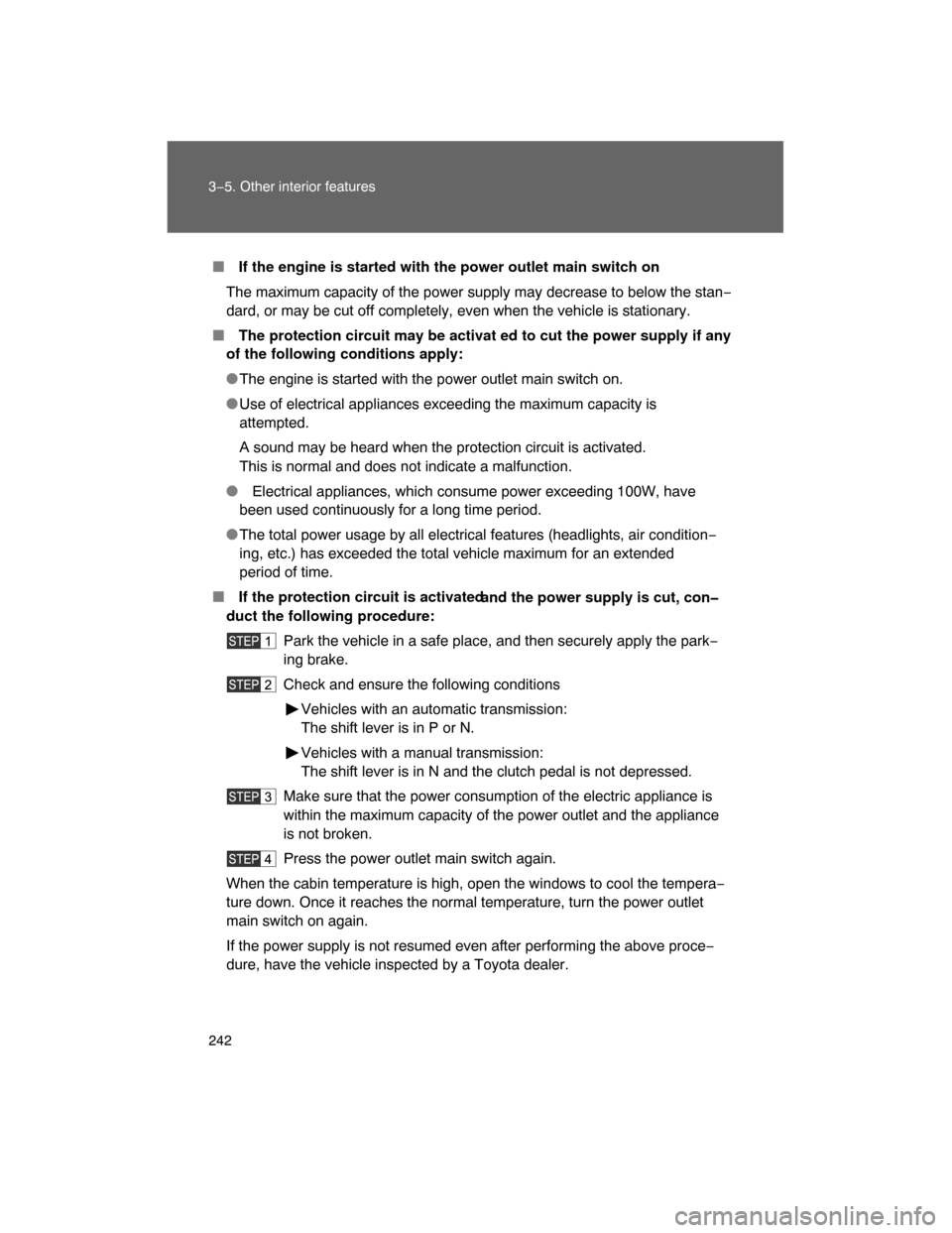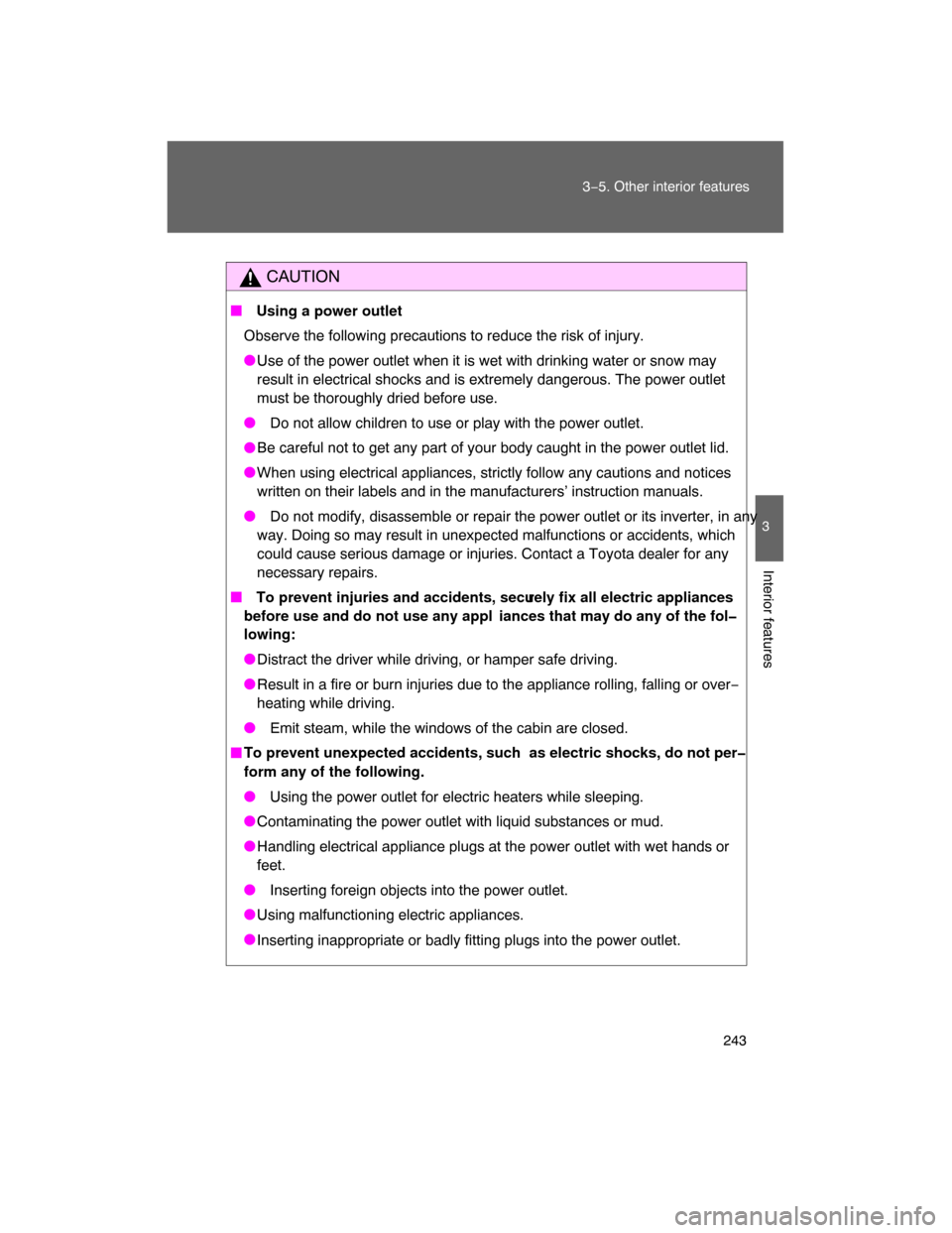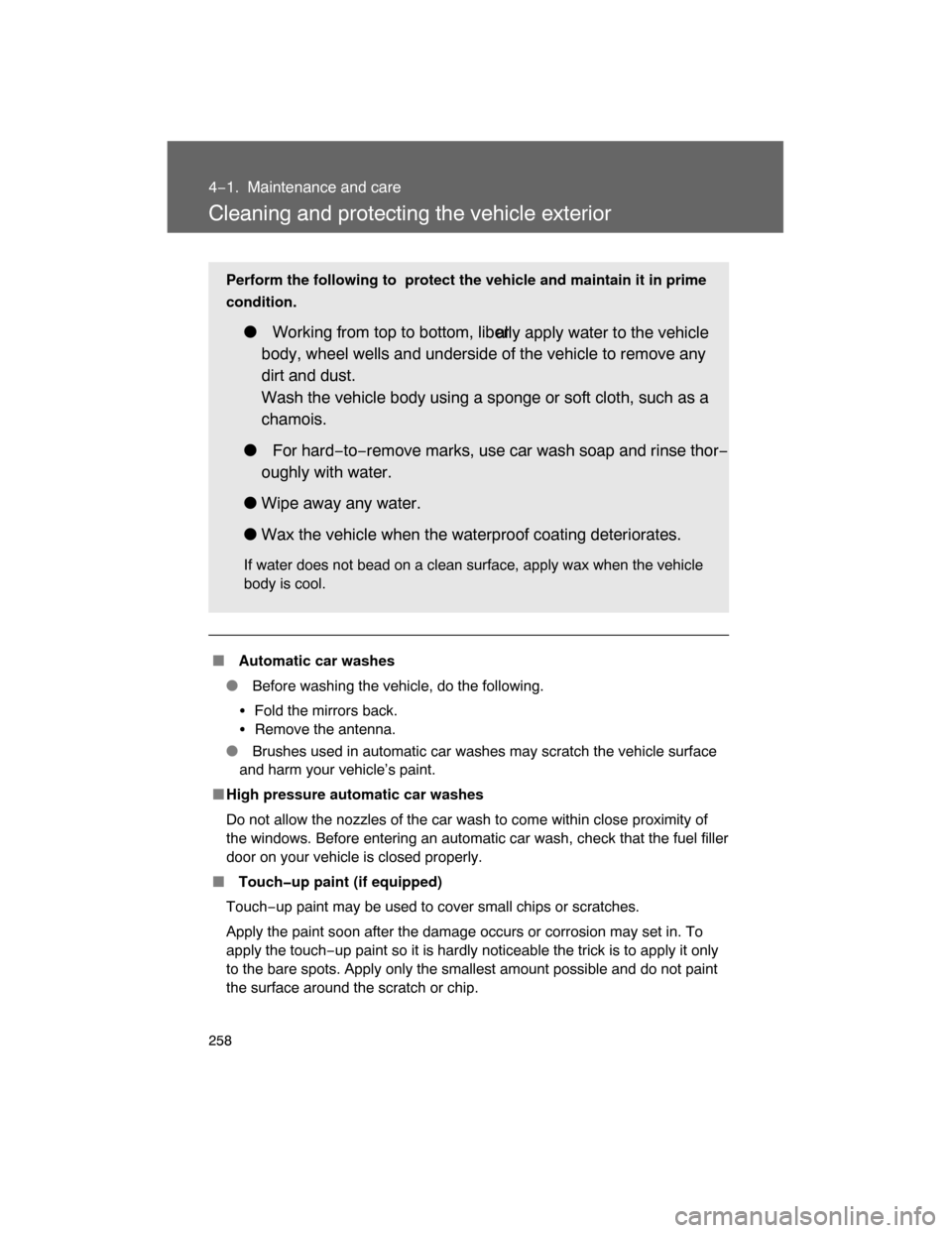Page 186 of 400

189
3−1. Using the air conditioning system and defogger
3
Interior features
� Using the system in recirculated air mode
The windows will fog up more easily if the recirculated air mode is used for
an extended period.
� When outside air temperature approaches 32�F (0�C)
The air conditioning system may not operate even when
is pressed.
� When
is selected for the air outlets used
For your driving comfort, air flowing to the feet may be warmer than air flow−
ing to the upper body depending on the position of the temperature adjust−
ment dial.
CAUTION
� To prevent the windshield from fogging up
Do not set the air outlet selection dial to during cool air operation in
extremely humid weather. The difference between the temperature of the
outside air and that of the windshield can cause the outer surface of the
windshield to fog up, blocking your vision.
NOTICE
� To prevent battery discharge
Do not leave the air conditioning system on longer than necessary when the
engine is stopped.
A/C
Page 187 of 400
190
3−1. Using the air conditioning system and defogger
Rear window defogger
� The rear window defogger can be operated when
The engine switch is in the ON position.
NOTICE
� To prevent battery discharge
Turn the rear window defogger off when the engine is off.
Clear the rear window using the defogger.
ON/OFF
Press the button to turn on the
rear window defogger. The
indicator light will come on.
The defogger will automatically
turn off after 15 to 240 minutes.
The operation time changes
according to the ambient tem−
perature and vehicle speed.
Pressing the button again also
turns the defogger off.
Page 210 of 400

213
3−2. Using the audio system
3
Interior features
� Discs that can be used
Discs with the marks shown below can be used.
Playback may not be possible depending on recording format or disc fea−
tures, or due to scratches, dirt or deterioration.
� MP3 and WMA player protection feature
To protect the internal components, playback is automatically stopped when
a problem is detected while the MP3 and WMA player is being used.
� If discs are left inside the MP3 and WMA player or in the ejected posi�
tion for extended periods
Discs may be damaged and may not play properly.
�Lens cleaners
Do not use lens cleaners. Doing so may damage the MP3 and WMA player.
� MP3 and WMA files
MP3 (MPEG Audio LAYER3) is a standard audio compression format.
Files can be compressed to approximately 1/10 of their original size by using
MP3 compression.
WMA (Windows Media
TM Audio) is a Microsoft audio compression format.
This format compresses audio data to a size smaller than that of the MP3
format.
There is a limit to the MP3 and WMA file standards and to the media/formats
recorded by them that can be used.
�MP3 file compatibility
�Compatible standards
MP3 (MPEG1 LAYER3, MPEG2 LSF LAYER3)
MessageCauseCorrection
Procedures
NO MUSICThis indicates that no
playable data is
included in the disc
Eject the disc
Page 213 of 400
216 3−2. Using the audio system
�There is a wide variety of freeware and other encoding software for
MP3 and WMA files on the market, and depending on the status of the
encoding and the file format, poor sound quality or noise at the start of
playback may result. In some cases, playback may not be possible at
all.
�When files other than MP3 or WMA files are recorded on a disc, it may
take more time to recognize the disc and in some cases, playback may
not be possible at all.
�Microsoft, Windows, and Windows Media are the registered trade−
marks of Microsoft Corporation in the U.S. and other countries.
NOTICE
� CDs and adapters that cannot be used (
P. 206)
� CD player precautions (
P. 207)
Page 239 of 400

242 3−5. Other interior features
� If the engine is started with the power outlet main switch on
The maximum capacity of the power supply may decrease to below the stan−
dard, or may be cut off completely, even when the vehicle is stationary.
� The protection circuit may be activat ed to cut the power supply if any
of the following conditions apply:
�The engine is started with the power outlet main switch on.
�Use of electrical appliances exceeding the maximum capacity is
attempted.
A sound may be heard when the protection circuit is activated.
This is normal and does not indicate a malfunction.
� Electrical appliances, which consume power exceeding 100W, have
been used continuously for a long time period.
�The total power usage by all electrical features (headlights, air condition−
ing, etc.) has exceeded the total vehicle maximum for an extended
period of time.
� If the protection circuit is activated
and the power supply is cut, con�
duct the following procedure:
Park the vehicle in a safe place, and then securely apply the park−
ing brake.
Check and ensure the following conditions
Vehicles with an automatic transmission:
The shift lever is in P or N.
Vehicles with a manual transmission:
The shift lever is in N and the clutch pedal is not depressed.
Make sure that the power consumption of the electric appliance is
within the maximum capacity of the power outlet and the appliance
is not broken.
Press the power outlet main switch again.
When the cabin temperature is high, open the windows to cool the tempera−
ture down. Once it reaches the normal temperature, turn the power outlet
main switch on again.
If the power supply is not resumed even after performing the above proce−
dure, have the vehicle inspected by a Toyota dealer.
Page 240 of 400

243
3−5. Other interior features
3
Interior features
CAUTION
� Using a power outlet
Observe the following precautions to reduce the risk of injury.
�Use of the power outlet when it is wet with drinking water or snow may
result in electrical shocks and is extremely dangerous. The power outlet
must be thoroughly dried before use.
� Do not allow children to use or play with the power outlet.
�Be careful not to get any part of your body caught in the power outlet lid.
�When using electrical appliances, strictly follow any cautions and notices
written on their labels and in the manufacturers’ instruction manuals.
� Do not modify, disassemble or repair the power outlet or its inverter, in any
way. Doing so may result in unexpected malfunctions or accidents, which
could cause serious damage or injuries. Contact a Toyota dealer for any
necessary repairs.
� To prevent injuries and accidents, secu
rely fix all electric appliances
before use and do not use any appl iances that may do any of the fol�
lowing:
�Distract the driver while driving, or hamper safe driving.
�Result in a fire or burn injuries due to the appliance rolling, falling or over−
heating while driving.
� Emit steam, while the windows of the cabin are closed.
�To prevent unexpected accidents, such as electric shocks, do not per�
form any of the following.
� Using the power outlet for electric heaters while sleeping.
�Contaminating the power outlet with liquid substances or mud.
�Handling electrical appliance plugs at the power outlet with wet hands or
feet.
� Inserting foreign objects into the power outlet.
�Using malfunctioning electric appliances.
�
Inserting inappropriate or badly fitting plugs into the power outlet.
Page 253 of 400
256 3−5. Other interior features
NOTICE
� To avoid the compass malfunctions
Do not place magnets or any metal objects on or near the accessory meter.
Doing this may cause a malfunction of the compass sensor.
� To ensure normal operation of the compass
� Do not perform circling calibration of the compass in a place where the
earth’s magnetic field is subject to interference by artificial magnetic fields.
�
During calibration, do not operate electric systems (power windows, etc.)
as they may interfere with the calibration.
Page 254 of 400

258
4−1. Maintenance and care
Cleaning and protecting the vehicle exterior
� Automatic car washes
� Before washing the vehicle, do the following.
�Fold the mirrors back.
�Remove the antenna.
� Brushes used in automatic car washes may scratch the vehicle surface
and harm your vehicle’s paint.
�High pressure automatic car washes
Do not allow the nozzles of the car wash to come within close proximity of
the windows. Before entering an automatic car wash, check that the fuel filler
door on your vehicle is closed properly.
� Touch�up paint (if equipped)
Touch−up paint may be used to cover small chips or scratches.
Apply the paint soon after the damage occurs or corrosion may set in. To
apply the touch−up paint so it is hardly noticeable the trick is to apply it only
to the bare spots. Apply only the smallest amount possible and do not paint
the surface around the scratch or chip. Perform the following to protect the vehicle and maintain it in prime
condition.
� Working from top to bottom, liber
ally apply water to the vehicle
body, wheel wells and underside of the vehicle to remove any
dirt and dust.
Wash the vehicle body using a sponge or soft cloth, such as a
chamois.
� For hard−to−remove marks, use car wash soap and rinse thor−
oughly with water.
�
Wipe away any water.
�
Wax the vehicle when the waterproof coating deteriorates.
If water does not bead on a clean surface, apply wax when the vehicle
body is cool.